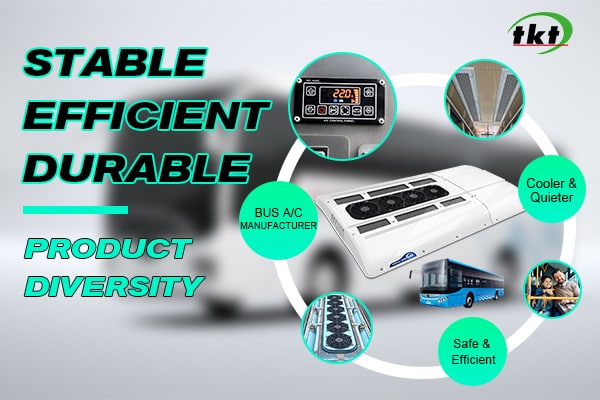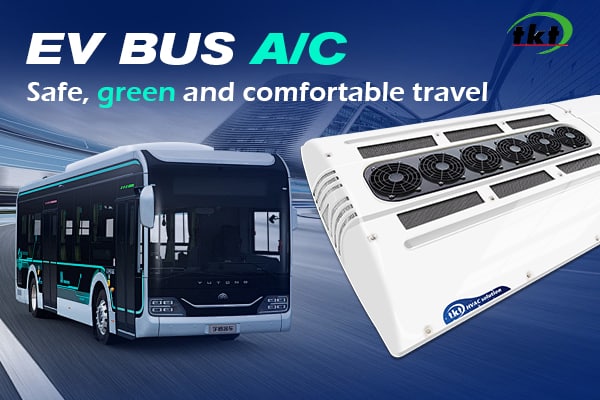Memilih sistem pendingin udara yang tepat untuk bus Anda sangat penting untuk memastikan kenyamanan perjalanan bagi penumpang, terutama saat cuaca panas. With a plethora of options available, it can be overwhelming to determine which system best meets your needs. In this comprehensive guide, we will delve into the different types of bus air conditioning systems, their components, standar kinerja, dan bagaimana memilih opsi yang paling efisien dan ekonomis untuk kendaraan Anda.
Memahami Sistem Pendingin Udara Bus
Jenis Sistem Pendingin Udara
Sistem pendingin udara bus dapat dikategorikan menjadi dua tipe utama: Produsen Peralatan Asli (OEM) sistem dan sistem purnajual.
– Sistem OEM: Sistem ini diintegrasikan ke dalam bus selama perakitannya. Mereka dirancang untuk bekerja secara lancar dengan sistem HVAC bus yang sudah ada, memastikan kinerja dan keandalan yang optimal.
– Sistem Purna Jual: Dipasang pasca produksi, sistem ini dapat dihubungkan ke sistem HVAC dasbor yang ada atau berfungsi sebagai unit mandiri. Mereka menawarkan fleksibilitas dan dapat disesuaikan dengan kebutuhan pendinginan tertentu.
Di masa lalu 24 bertahun-tahun, Solusi TKT EV telah berkembang menjadi OEM pilihan 100% AC bus dan sistem manajemen termal baterai Tiongkok, seperti Yutong, Nanjing Jinlong, Xiamen Jinlong, dll.. (Pendingin Udara Bus), CIMC, Xinfei, Hongyu, dll.. Di pasar internasional, TKT adalah OEM Tata Motors, Tata Marco Polo, Daewoo Motor, dll., dan ekspor ke lebih 85 negara dengan pusat penjualan dan layanan.
Komponen-komponen kunci
A sistem pendingin udara bus berkualitas tinggi terdiri dari beberapa komponen penting:
– Kompresor: Jantung dari sistem, typically mounted on the engine or a separate power source, compresses the refrigerant and circulates it through the system.
– Evaporator: Located in the driver’s area or throughout the bus, the evaporator cools the air by absorbing heat.
– Kondensator: Mounted on the roof or skirt, it releases the absorbed heat to the outside air.
– Kontrol: These include switches, thermostats, and electronic controls to manage the system’s operation.
– Additional Evaporators: These can be hanging or flush-mounted, ensuring uniform cooling throughout the bus.

Selecting the Right System
Performance Standards
When selecting an air conditioning system for ev buses, it is essential to consider the performance standards set by industry authorities. The National Congress of School Transportation and the American Public Transit Association provide guidelines to ensure systems meet minimum cooling requirements.
– National School Bus Specifications:
— Standard Performance: The system should cool the interior from 100°F to 80°F within 30 menit.
— High Performance: Sistem harus mendinginkan interior dari 100°F hingga 70°F di dalamnya 30 menit.
– Spesifikasi Asosiasi Angkutan Umum Amerika:
— Persyaratan Kapasitas dan Kinerja: Sistem ini harus mengurangi suhu kompartemen penumpang dari 115°F menjadi 95°F di dalamnya 20 menit setelah mesin dihidupkan.
— Kondisi Lingkungan yang Lebih Panas: Sistem harus mengurangi suhu dari 110°F menjadi 70°F (±3°F) di dalam 30 menit untuk 30-, 35-, dan bus 40 kaki.
Pertimbangan Kapasitas BTU
Memahami BTU (Unit Termal Inggris) kapasitas sangat penting dalam mengevaluasi efektivitas unit sistem AC. BTU mengukur jumlah panas yang dibutuhkan untuk menaikkan suhu satu pon air sebesar satu derajat Fahrenheit.
– Kapasitas Kotor: Ini adalah kapasitas terendah di antara evaporator, kondensator, dan kompresor, mewakili mata rantai terlemah sistem.
– Kapasitas Bersih: Meski jarang digunakan, metode ini menggunakan beberapa persamaan simultan untuk menyeimbangkan sistem.
Penting untuk dicatat bahwa tidak ada metode pemeringkatan BTU universal dalam industri AC bus. The most reliable way to assess a system’s performance is through a pull-down test, where the system’s ability to cool the bus interior is measured under specified conditions.
Practical Recommendations
– Work with Your Dealer: Collaborate with your dealer to select a system tailored to your bus’s cooling needs. Consider the power draw of the system to ensure it does not overburden the vehicle’s alternator capacity.
– Performance Pull-Down Test: Require a performance pull-down test to evaluate the system’s ability to cool the bus interior effectively.
– Standardized BTU Ratings: Insist on BTU/hour capacities recorded in an industry-standard format, such as those provided by the Society of Automotive Engineers (SAE).
Kesimpulan
Choosing the right air conditioning system for your bus requires careful consideration of various factors, including system type, components, standar kinerja, and BTU capacity. By adhering to industry guidelines and working closely with your dealer, you can ensure that your bus is equipped with an efficient and effective cooling system, providing a comfortable environment for passengers and enhancing the overall travel experience.



